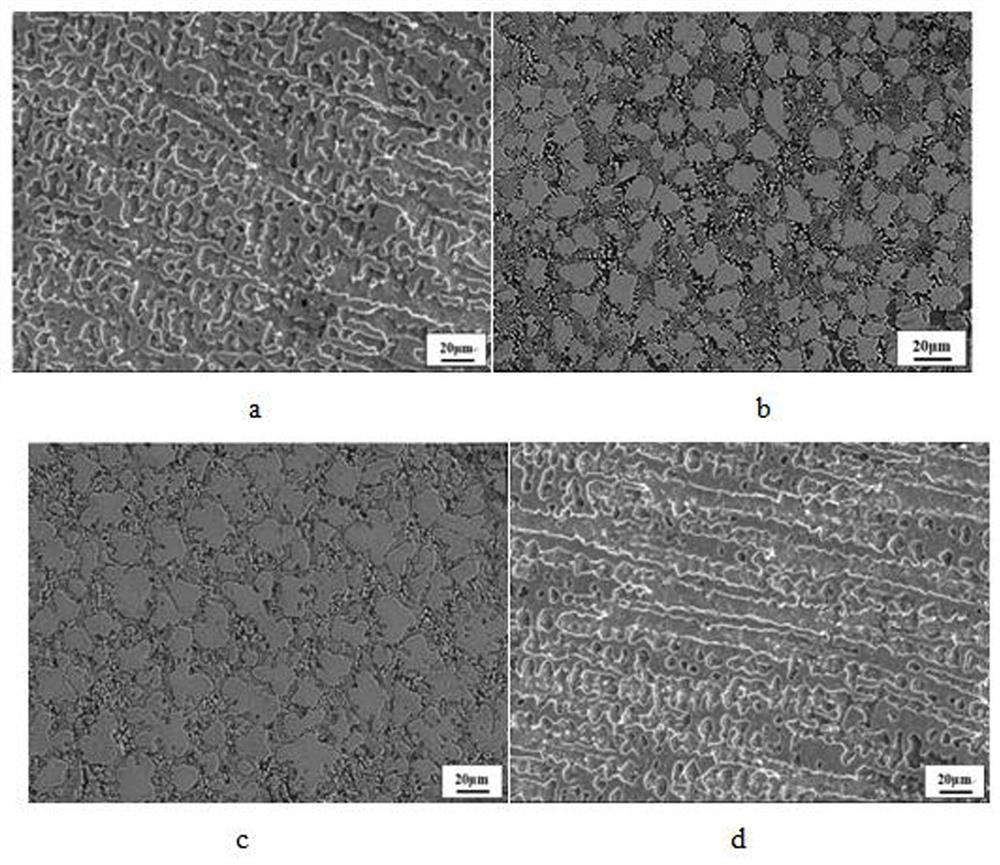A novel high-temperature cl-corrosion-resistant nitrogen-containing low-nickel alloy and preparation method thereof
A high-temperature, nickel-alloy technology, applied in the field of new high-temperature Cl-corrosion-resistant nitrogen-containing low-nickel alloys and their preparation, can solve problems such as dissolution, different alloy design ideas, corrosion, etc.
- Summary
- Abstract
- Description
- Claims
- Application Information
AI Technical Summary
Problems solved by technology
Method used
Image
Examples
preparation example Construction
[0029] A new type of high temperature resistant Cl - The preparation method of corroded nitrogen-containing low-nickel alloy comprises the following steps:
[0030] Step 1. Calculate and weigh the raw materials of alloy elements according to chemical composition, wherein N element is added in the form of MnN and CrN.
[0031]Step 2. In addition to MnN and CrN, select Mn, Mo, Cr, V, Al, Ti, Nb and W bulk metals with a purity of more than 99.9% to adjust the ratio of other elements, mix the alloy raw materials, and put the vacuum melting furnace After vacuuming to a degree of vacuum less than 10Pa, bulk metal is added.
[0032] Step 3. After the alloy is completely melted, vacuum degassing is carried out at 1580° C. for 10 minutes.
[0033] Step 4. Use British PSI tightly coupled argon atomization equipment, and feed 97%Ar+3%N 2 The atomization temperature is 1600-1680℃, the melt flow rate is 3.5-4 kg / min, and the atomizing gas pressure is 3.5-4.5MPa.
[0034] Step 5, alloy ...
Embodiment 1
[0041] The specific composition of the alloy is: Ni: 42.0wt%, Cr: 24.0wt%, Mn: 7.0wt%, Si: 1.6wt%, Mo: 7.0wt%, Cu: 0.24wt%, Co: 0.81wt%, N: 0.21 wt%, Al: 1.4wt%, Ti: 1.43wt%, Nb: 7.0wt%, W: 2.6wt%, V: 1.3wt%, and the rest are Fe and inevitable impurities. The preparation process is as follows:
[0042] A BL410F electronic balance (1 mg) was used to weigh the weight of the added metal under each ratio in the orthogonal test. Put all the alloy raw materials into the crucible of the vacuum induction furnace, seal the furnace cover and start vacuuming. After the vacuum degree in the furnace is less than 10Pa, start to send the electro-chemical material. When the alloy was completely melted, vacuum degassing was performed at 1580 °C for 10 min. Then use the British PSI tightly coupled argon atomization equipment, pass 97%Ar+3%N 2 The atomization temperature is 1650 °C, the melt flow rate is 3.8 kg / min, and the atomizing gas pressure is 4.0 MPa. Subsequently, the temperature was ...
Embodiment 2
[0045] The specific composition of the alloy is: Ni: 44.0wt%, Cr: 24.0wt%, Mn: 7.0wt%, Si: 1.6wt%, Mo: 6.5wt%, Cu: 0.24wt%, Co: 0.81wt%, N: 0.18 wt%, Al: 1.4wt%, Ti: 1.43wt%, Nb: 6.5wt%, W: 2.0wt%, V: 1.3wt%, and the rest are Fe and inevitable impurities. The preparation process is as follows:
[0046] A BL410F electronic balance (1 mg) was used to weigh the weight of the added metal under each ratio in the orthogonal test. Put all the alloy raw materials into the crucible of the vacuum induction furnace, seal the furnace cover and start vacuuming. After the vacuum degree in the furnace is less than 10Pa, start to send the electro-chemical material. When the alloy was completely melted, vacuum degassing was performed at 1580 °C for 10 min. Then use the British PSI tightly coupled argon atomization equipment, pass 97%Ar+3%N 2 The atomization temperature is 1650 °C, the melt flow rate is 3.8 kg / min, and the atomizing gas pressure is 4.0 MPa. Subsequently, the temperature was ...
PUM
 Login to View More
Login to View More Abstract
Description
Claims
Application Information
 Login to View More
Login to View More - R&D
- Intellectual Property
- Life Sciences
- Materials
- Tech Scout
- Unparalleled Data Quality
- Higher Quality Content
- 60% Fewer Hallucinations
Browse by: Latest US Patents, China's latest patents, Technical Efficacy Thesaurus, Application Domain, Technology Topic, Popular Technical Reports.
© 2025 PatSnap. All rights reserved.Legal|Privacy policy|Modern Slavery Act Transparency Statement|Sitemap|About US| Contact US: help@patsnap.com


